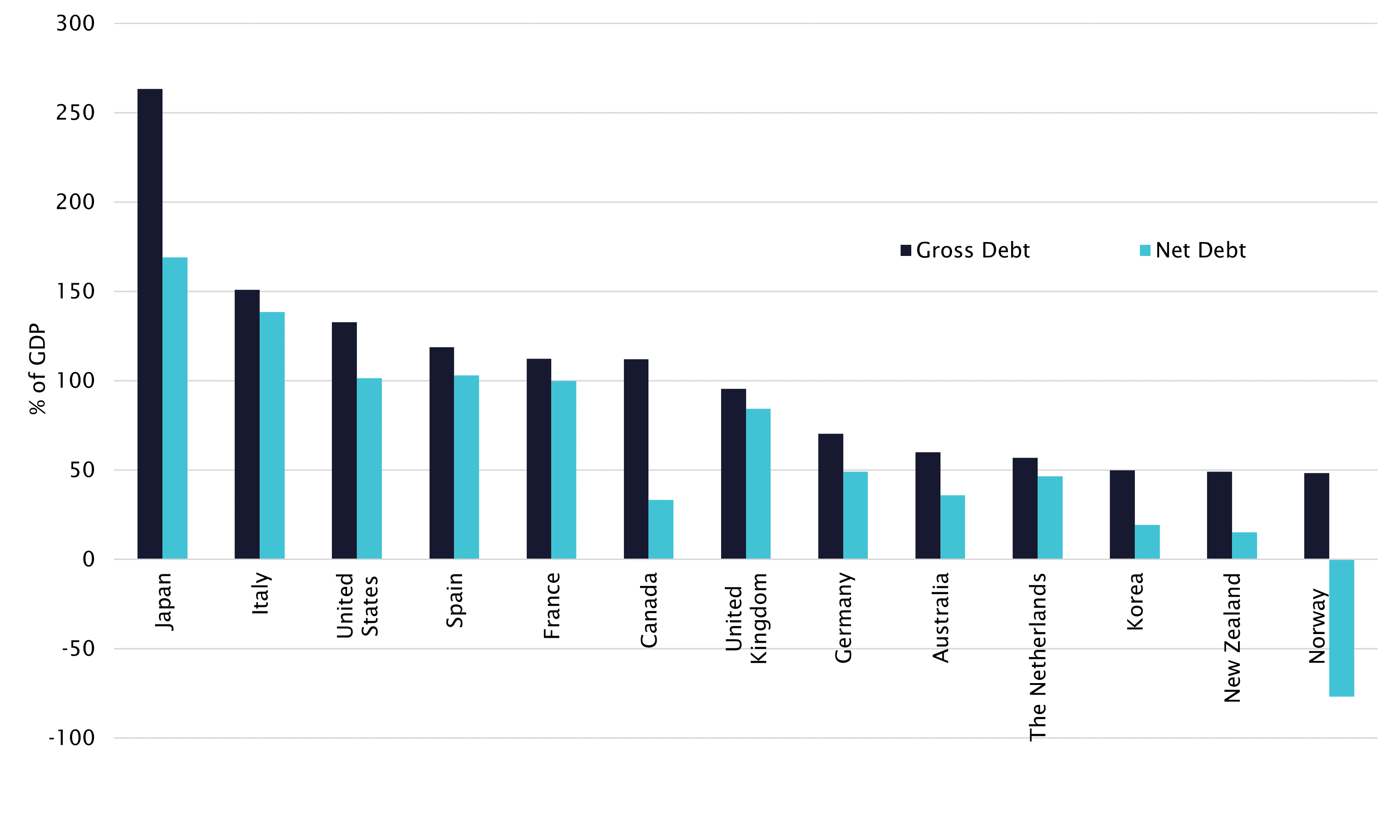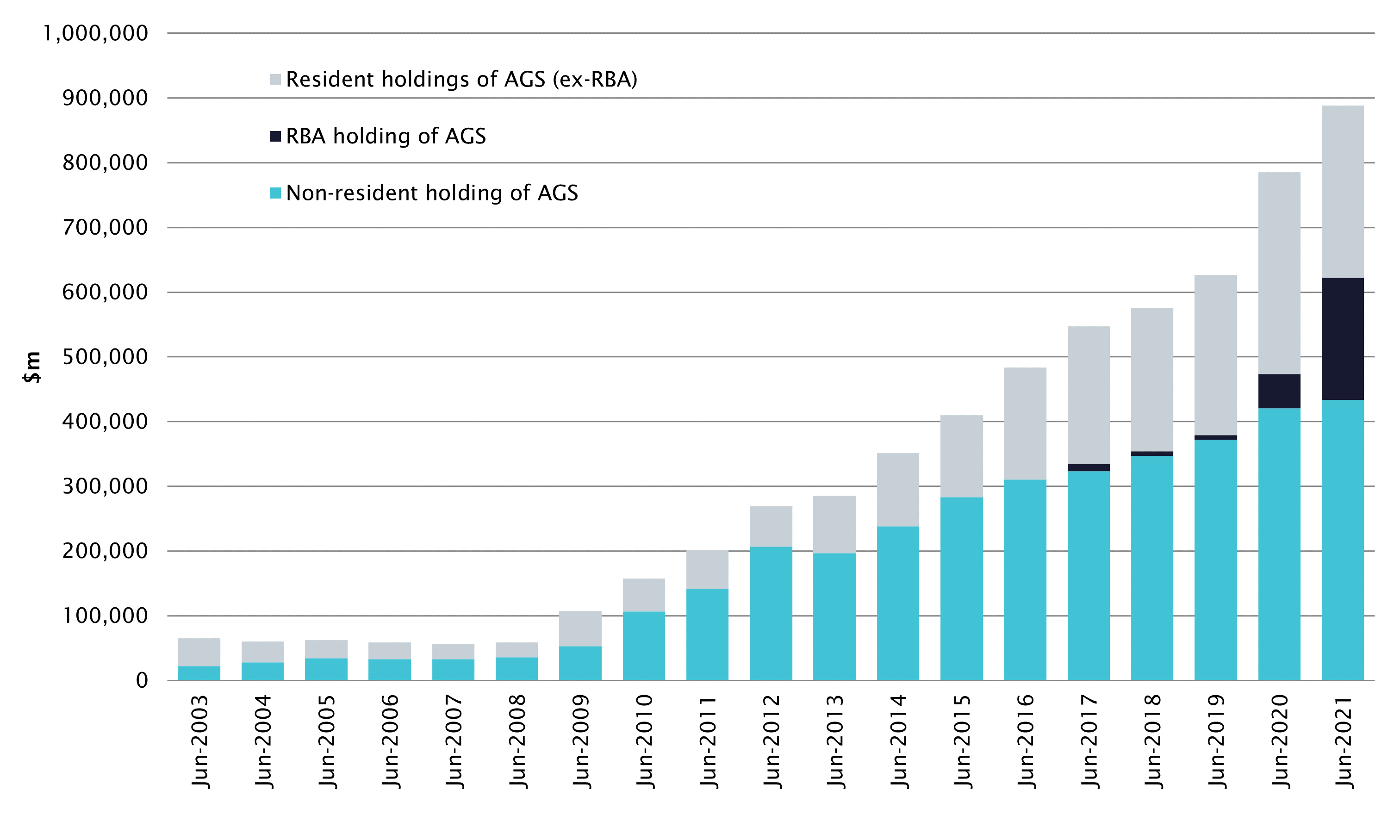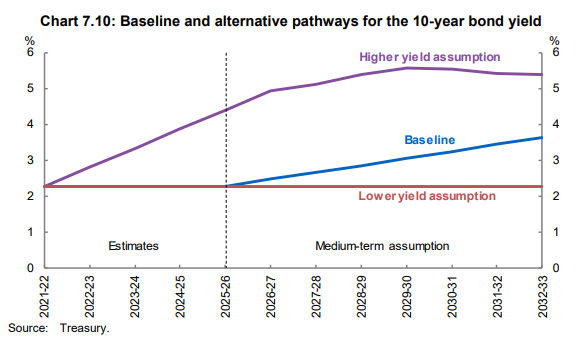Gregory O’Brien, Statistics and Mapping
Key issue
Australian Government debt has increased to levels not experienced since the 1950s as economic support during the COVID-19 pandemic led to increased budget deficits. As interest rates in Australia and globally have started to increase in response to recent inflationary pressures, both the size and servicing of this debt will be an issue for future Australian governments.
In Australia, and in countries around the world,
government economic support packages in response to the COVID-19 pandemic have
led to large increases in government debt, continuing a trend of increasing
government debt since the global financial crisis (GFC). Over the pandemic, Australian
Government gross debt increased from $534.4 billion in March 2019 to $885.5 billion in April 2022 and is now at the
highest level relative to GDP (gross domestic product) since
the 1950s when debt accrued during the Second World War was still on the
Australian Government balance sheet (p. 8).
This article provides an overview of the structure
of Australian Government debt, recent trends in the total amount of Australian
Government debt outstanding, international comparisons of government debt, and
the relationship between government debt and interest rates.
Australian Government debt issuance and key terms
Australian Government debt is closely linked with
the Australian Government Budget. Government spending is funded either through
receipts- primarily taxes- or through borrowing. In the Budget, the difference
between receipts and payments is referred to as the cash balance and has been
in deficit (payments have exceeded receipts) since 2007–08. These deficits have
led to a steady increase in the level of Australian Government debt.
The Australian
Office of Financial Management (AOFM) manages Australian Government debt
issuance. The AOFM issues 3 types of debt securities, collectively known as
Australian Government Securities (AGS):
- Treasury bonds: medium to long-term debt
securities that pay interest at a fixed annual rate every 6 months. These are
the largest type of AGS, representing 92.8% of AGS on issue as of 20 May 2022.
- Treasury indexed bonds: medium to
long-term debt securities that include adjustments for inflation, as measured
by the Consumer Price Index (CPI). Both the capital value and the interest
payments are adjusted quarterly based on changes in inflation. These
represented 4.1% of AGS on issue as of 20 May 2022.
- Treasury notes: short-term debt
securities with maturations up to one year. These represented 3% of AGS on
issue as of 20 May 2022.
The total face value of AGS on issue at a given
point in time, which represents the total amount that will need to be repaid
when all extant AGS mature, is used as a measure of gross debt in the Budget. The AOFM publishes a weekly figure for total
AGS on issue, broken down into the 3 types described above, as well as more
detailed information in its data hub.
While gross debt is a good representation of the
total magnitude of outstanding debt, it may not be the best measure for
analysing debt sustainability depending on the financial assets available to
service or pay off this debt. For this reason, the
Budget also provides figures for Australian Government net debt,
defined as ‘the sum of interest-bearing liabilities less the sum of selected
financial assets (cash and deposits, advances paid and investments, loans and
placements)’ (p. 347). These financial assets are primarily held in
government investment funds, such as the Future Fund.
Whether gross debt or net debt is a better measure
of government indebtedness will depend on the context of the analysis. The
difference between these measures is described in more detail when looking at
international comparisons of government debt below.
Trends in Australian Government debt
The
Budget provides historical data for a range of budget aggregates back to 1970–71
in the Historical Australian Government Data statement of Budget paper no. 1 (Statement 10 in 2022–23). When comparing levels
of debt across long periods of time, it is useful to convert the dollar values
of debt into a relative measure, usually the ratio to GDP, to control for the
impacts of price changes across the economy. Figure 1 below shows gross debt,
represented by the total face-value of AGS outstanding, as a ratio to GDP over
the last 50 years with the Budget estimates through to 2025–26 and the interest
payments on this debt for the same period, also as a ratio to GDP.
Figure
1 Australian Government total AGS on issue (gross debt) and interest
paid

Source: Australian
Government, Budget
Strategy and Outlook: Budget Paper No. 1: 2022–23, p.348.
This graph shows that Australian Government debt
fluctuated around 20% of GDP from the early 1970s to the mid-1990s with one
period of substantial falls in the late 1980s. Government debt then trended
down between the mid-1990s and the GFC in 2007–08, as the Howard Government
prioritised debt repayment and budget surpluses. From 2008–09 in the wake of
the GFC and associated government economic support packages, government debt
has steadily increased as a ratio to GDP, with 2018–19 the only financial year
over this period which saw a fall in this measure. The
2022–23 Budget forecasts government debt to increase over the next few years
before falling slightly in 2025–26 (p.348). In dollar terms, gross debt is
forecast to increase to over a trillion dollars in 2023–24, reaching a peak
over the forward estimates of $1.193 trillion in April 2026. While current and
forecast debt to GDP ratios are high relative to recent history, they
are still well below the peak reached following the Second World War of over
120% of GDP (p.8) (see
Figure 2).
Figure 2 Australian Government
gross debt to GDP ratio
Sources: pre-1970:
A. Barnard, Source Papers in Economic History via Treasury and The Conversation; post-1970: Australian
Government, Budget Strategy and Outlook: Budget Paper No. 1: 2022–23, p.348.
Note: There are differences in methodology
between the sources, so some care should be taken in comparing recent and
historical figures. The figures for 2021 - 22 to 2024 - 25 are Budget estimates.
These increases in the level of Australian
Government debt since the GFC have not seen a commensurate rise in the amount
of interest paid on this debt because interest rates on Australian Government
debt fell over the period, largely offsetting the increase in the level of
debt. This period of low interest rates has seen interest payments stay at
historically low levels, around 1% of GDP, which is less than half the amount
paid in the 1980s despite the current level of debt being twice the level of
that period.
Interest rates on
Australian Government debt have started to rise in 2022 and have continued
to rise since the 2022–23 Budget was released in March. This increase has been
common to many countries globally in response to inflationary pressures and tightening
of monetary policy by central banks. If interest rates stay above the level
forecast in the Budget, interest payments will increase over time as new debt
is issued at these higher rates and existing debt that was issued at lower
historical interest rates matures and is refinanced.
International comparison of General Government debt
Despite increases in Australian Government gross
and net debt since the GFC, levels of both remain relatively low when compared
to other countries. The International Monetary Fund (IMF) publishes data on
General Government sector gross and net debt across countries. The IMF approach
includes all levels of government (which, in Australia, includes Commonwealth, state
and local governments), which allows more meaningful comparison across
countries with different structures of government. Figure 3 shows IMF estimates
of gross debt and net debt for 2021 across several advanced countries from the IMF’s fiscal monitor 2022 publication.
Figure 3 IMF General Government
gross and net debt (% of GDP) estimates, 2021

Source: International Monetary Fund (IMF), Fiscal
Monitor: Fiscal Policy from Pandemic to War, (Washington, DC: IMF, April 2022).
Figure 3 shows the important difference between
gross debt and net debt when comparing across countries. Countries with
significant financial assets, such as Canada (held by public pension plans) and
Norway (held in a sovereign wealth fund) have much lower levels of net debt
than gross debt once these financial assets are incorporated. This is also
relevant to a lesser extent for Australia, where the $200 billion Future Fund and other smaller
government investment funds have
contributed to a widening gap between gross debt and net debt over time (p. 1).
There is variation across countries in the degree
to which these financial assets are held to meet future specified expenditure
purposes, and some debate as to whether it is appropriate to consider these
assets as offsetting government debt. Gross debt is a more consistent measure
across countries, as there is less variation due to different social security
regimes.
As Figure 3 shows, despite the increase in both
Australian Government net debt and gross debt since 2007–08, the level of
government debt compared to international peers remains relatively low. At just
below 60%, the Australian Government gross debt to GDP ratio is less than half
that of the US, and less than a quarter that of Japan. Both gross
debt to GDP and net debt to GDP ratios are lower than any G7 members, and
similar to mid-sized economies including Korea and New Zealand.
Holdings of Australian Government Securities
Australian Government debt is owned by a range of
Australian and international investors. The AOFM provides information on the
share of AGS on issue owned by non-residents. Under the Guarantee of State
and Territory Borrowing Appropriation Act 2009, the AOFM
was tasked with establishing a Public Register of Government Borrowings. As the AOFM has no powers to compel financial
intermediaries to disclose the beneficial owners of AGS they administer, the
register has limited information on the countries of residence of foreign
owners of AGS.
The Reserve Bank of Australia (RBA) started
purchasing significant amounts of AGS on the secondary market as
part of its monetary policy response to the COVID-19 pandemic in order to lower
yields on government bonds and maintain liquidity in bond markets. This has led
to the RBA holding a growing share of the total AGS on issue. The RBA ceased
purchasing AGS in February 2022, and in its May 2022 Statement
on monetary policy decided:
[…]
the Board will not reinvest the proceeds of maturing government bonds and
expects the Bank’s balance sheet to decline significantly over the next couple
of years as the Term Funding Facility comes to an end. The Board is not
currently planning on selling the government bonds that the Bank has purchased
during the pandemic. (p. 3)
This decision means that RBA ownership of AGS
should slowly recede as the existing AGS owned by the RBA mature. As total
outstanding AGS is not forecast to decline, these maturing bonds will need to
be absorbed by the resident and non-resident markets for AGS. Given the
duration of these bonds, this process is likely to slowly occur over the next
decade.
Figure 4 below shows the ownership of AGS by non-residents,
the RBA, and other domestic owners. The chart shows resident holdings of AGS
have steadily increased over the last decade, while non-resident holdings have
fallen as a proportion of the total, and RBA holdings increased. The reduction
in the proportion of AGS held by non-residents reduces the risk of interest
rate volatility associated with capital flight, when non-resident investors sell
overseas assets and repatriate the money, often in response to market
volatility.
Figure 4 Resident, RBA, and
non-resident holdings of AGS, 2003–2021

Source: Parliamentary calculations based
on Australian Office of Financial Management, Non-Resident Holdings of AGS,
and Reserve Bank of Australia, Holdings of Australian
Government Securities and Semis
Government debt sensitivity to interest rate
changes
The Australian Government Budget provides
sensitivity analyses to show how varying certain important assumptions (particularly
the iron ore price and yields on 10-year government bonds) would impact on the
economic and fiscal forecasts contained in the Budget. For the 2022–23 Budget,
the sensitivity analysis is contained in Budget
paper no. 1, statement 7: forecasting performance and sensitivity analysis.
Yield sensitivity analysis models the impact on the
gross debt to GDP ratio if interest rates over the medium term differ from
those assumed in the Budget (the baseline forecast) while maintaining all other
forecasts. The interest rate on 10-year treasury bonds is used as the benchmark
rate. Figure 5 below shows the path of interest rates used by Treasury in the
higher yield and lower yield scenarios in the left panel, and the impact these
higher or lower yields would have on the forecast gross debt to GDP ratio in
the right panel. If interest rates follow a higher yield path than the Budget
forecasts, then the gross debt to GDP ratio will continue to rise for longer
and fall slower than is forecast in the Budget.
Figure 5 Yield Sensitivity
Analysis from Budget 2022–23


Source: Budget
Strategy and Outlook, Budget Paper No. 1: 2022–23, pp. 215–216.
The market
interest rate on 10-year Treasury Bonds in mid-May 2022 is over 3.25% and
reached 3.5% for several days in early May 2022. If interest rates stay at
levels above the level of 2.2% forecast in the Budget in March 2022, the gross
debt to GDP ratio would be expected to be higher than the levels forecast in
the Budget. However, it is important to note that the weighted average cost of
borrowing on Australian Government debt responds slowly to changes in market
interest rates, as the fixed-term nature of treasury bonds means that only new
issuance (including the rolling over of maturing bonds) pays the higher current
interest rate while the existing stock of debt continues to pay interest at the
rate set when that debt was issued.
The sustainability of government debt
The increase in government debt to levels not
experienced in generations raises questions about the sustainability of this
level of debt. While there is no objective level of government debt to GDP
which is problematic, there are several factors worth considering when
analysing the sustainability of government debt.
When considering the Budget ramifications, reducing
the debt to GDP ratio does not necessarily require Budget surpluses. If
economic growth outstrips growth in the level of debt, then the debt to GDP
ratio will fall even if the Budget is in deficit. As the
Budget notes:
From a fiscal sustainability perspective, it
is the difference between nominal yields and nominal economic growth that
matters. If higher yields are accompanied by an economy growing at a faster
rate than the rate on government borrowing, this may be sufficient to improve
debt as a share of the economy over time, all else being equal. (p. 215)
The Parliamentary Budget Office (PBO) provides a Fiscal
Sustainability dashboard as part of its fiscal projections and
sustainability publications, which models gross debt to GDP ratios out to 2061
based on various scenarios for GDP growth, the Budget cash balance, and
interest rates.
Whether Australian Government debt is, or will
become, a problem depends on the future path of interest rates, economic
growth, and the Budget balance. Interest payments on Australian Government debt
reduce the amount of money available in the Budget for expenditure on government
services, or requires additional debt to be raised to fund these activities. However,
both international experience and Australian history show that countries can have
higher levels of government debt than are currently prevalent in Australia for
long periods of time without risking default or seeing a substantial decline in
their credit ratings.
Further reading
Australian Government, Statement 6: Debt Statement, and Statement 7: Forecasting Performance and Sensitivity Analysis, Budget Strategy and Outlook: Budget Paper No. 1: 2022–23.
Parliamentary Budget Office (PBO), Fiscal Sustainability, (Canberra: PBO, 2021).
PBO, Beyond the Budget 2021–22: Fiscal Outlook and Scenarios, (Canberra: PBO, 2021).
PBO, Net Debt and Investment Funds – Trends and Balance Sheet Implications, (Canberra: PBO, 2019).
Katrina Di Marco, Mitchell Pirie and Wilson Au-Yeung, A History of Public Debt in Australia, (Canberra: Treasury, 2009).
Back to Parliamentary Library Briefing Book
For copyright reasons some linked items are only available to members of Parliament.
© Commonwealth of Australia

Creative Commons
With the exception of the Commonwealth Coat of Arms, and to the extent that copyright subsists in a third party, this publication, its logo and front page design are licensed under a Creative Commons Attribution-NonCommercial-NoDerivs 3.0 Australia licence.